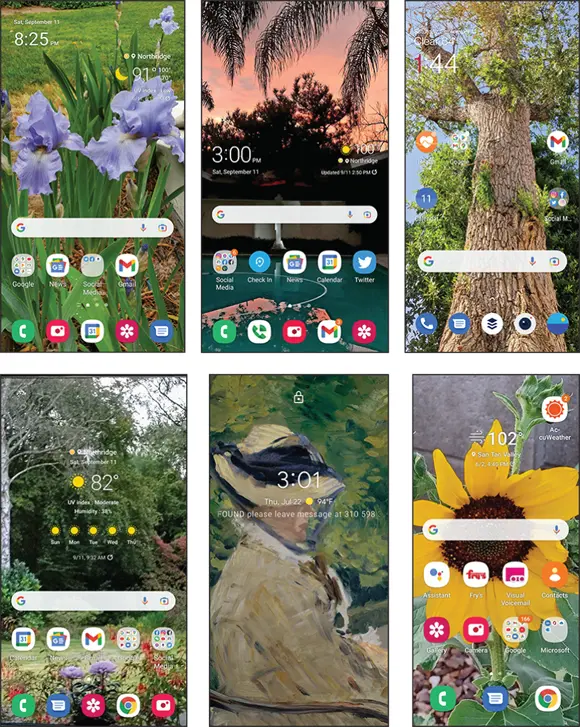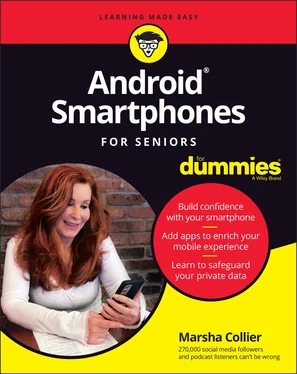Hopefully, this book can keep you from making embarrassing calls to your kids to “fix” your phone. And even better — this book might help you teach your kids a trick or two. My editors don’t necessarily identify with the over 55 crowd, but even they found some good ideas in this book.
So, buy the book. I know we’ll have fun learning together.
The idea for this book was born during the coronavirus pandemic, on the day that vaccinations became available in Los Angeles. I scoured the Internet, found the active link from the misleading information, and wanted to be sure that my over-65 neighbors could sign up for the vaccine as well.
I went from house to house, helping others sign up for an appointment (much to their relief). The problem was not necessarily determining where to go for shots, but rather how to schedule the appointments on their phones.
The over 55 crowd had problems with both Apple and Android phones. Although I’ve had short stints with iPhones, I am a loyal Android user. I prefer the interface, I love the idea that I can personalize what information I share (and with who), and most of all, because “Android is for everyone.”
From my research, I’ve found that not everyone rushes out to buy the latest, most expensive phones. I suspected as much because that’s my philosophy as well. So, I used six different phone models and brands, and not necessarily the latest-and-greatest. The introduction’s figure shows some of my “coauthors” for this book.

The Coauthors
The coauthor phones ran the latest version of Android, 11. They include a 2021 OnePlus 9 Pro 5G, a late 2019 Samsung Galaxy Note10+, 2019 Samsung Galaxy S10+, 2021 Samsung Galaxy A32 5G, 2018 Google Pixel 3XL, and a 2017 Pixel 2. I also checked the between Android versions on a 2019 Huawei P30 Pro running Android 10. Using all these phones was confusing at worst, but at best, I learned that the Android experience flows similarly through all the brands, with additional features, which I’ll show you in the book.
All these phones are impressive, and the manufacturers did a great job with the design and functionality. The oldest, the 2018 Google Pixel 3XL, is quite a surprise; I enjoyed using that phone as well.
I wrote this book using the pictured phones, all but one of which was running the Android 11 operating system. Android 12 launches in late 2021, so I used a OnePlus 9 5G on the beta tests of Android 12. Chapter 17has my impressions on the beta-testing experience.
I assume that you have used a smartphone — or at least used a computer. I also assume that you may be in the market for a phone or have just acquired one. I guide you through the intricacies of buying a phone that best meets your needs, the specific features to look for in a mobile service provider, the basic operations of navigating your Android smartphone, and the most important apps you need to master (even for photography and entertainment). I highlight ways to use your phone that we (my editors and I) expect will improve your Android experience. Most importantly, I present the content in nontechnical language!
I’m all about illustrating a book. Many figures illustrate the phone screens and tasks laid out in the chapters. You’ll also see small icons that point to special advice from me — here they are:
 Tips are short notes — from me to you — that make the process of using your smartphone easier.
Tips are short notes — from me to you — that make the process of using your smartphone easier.
 These notes are like tips, but a bit more technical sounding. I provide only the technical info that’s both important and worthwhile to know.
These notes are like tips, but a bit more technical sounding. I provide only the technical info that’s both important and worthwhile to know.
 Don’t forget these notes. They show up often and are good to stash in the back of your mind.
Don’t forget these notes. They show up often and are good to stash in the back of your mind.
 Warnings contain information that you need to heed. Sometimes, performing certain actions can cause an expensive problem, but don’t worry: You won’t find many of these.
Warnings contain information that you need to heed. Sometimes, performing certain actions can cause an expensive problem, but don’t worry: You won’t find many of these.
You can find a section on www.dummies.com with more Android tips and Android 12 features (after the Android 12 operating system fully rolls out). While visiting dummies.com , type Android Smartphones For Seniors For Dummiesin the search box to find the book’s Cheat Sheet. I also have a blog at https://mcollier.blogspot.com , where I post related articles.
In this book, I give you links and contact information for the tech support department for several major phone manufacturers, which should help with any immediate issue.
If you have specific questions, feel free to reach me by completing the contact form at my website ( www.coolebaytools.com/contact ) or on any of the social media platforms. I’d love to hear from you about the topics you want me to add to the next edition.
I also have a podcast, “Computer and Technology Radio,” which I host with Marc Cohen. You can find it on your favorite podcast platform.
Start reading this book anywhere you want. An incredible index can help you find almost any topic you need to learn about. Go to the table of contents and pick a chapter that interests you, or read the book from the beginning.
Interesting and helpful nuggets of information for you abound everywhere in this book. I really hope you enjoy it.
Part 1
Your Phone in the Android Universe
IN THIS PART …
Meeting the Android OS
Setting up a Google Account
Choosing a smartphone and accessories
Starting up and connecting your phone
Minding privacy and security
Chapter 1
Why Android? What’s the Deal?
IN THIS CHAPTER
 Knowing the origins and scope of Android
Knowing the origins and scope of Android
 Seeing why you need a Google Account
Seeing why you need a Google Account
 Recognizing the many choices
Recognizing the many choices
 Practicing privacy going forward
Practicing privacy going forward
The smartphone is undoubtedly the most common yet powerful personal technology in your life. In the United States market, you have basically this choice: an Apple iPhone (iOS) or an Android-based phone.
The smartphone platform you choose is a matter of preference. Some people use both Apple and Android products, but in the end usually tend to favor one platform over the other.
Читать дальше


 Tips are short notes — from me to you — that make the process of using your smartphone easier.
Tips are short notes — from me to you — that make the process of using your smartphone easier. These notes are like tips, but a bit more technical sounding. I provide only the technical info that’s both important and worthwhile to know.
These notes are like tips, but a bit more technical sounding. I provide only the technical info that’s both important and worthwhile to know. Don’t forget these notes. They show up often and are good to stash in the back of your mind.
Don’t forget these notes. They show up often and are good to stash in the back of your mind. Warnings contain information that you need to heed. Sometimes, performing certain actions can cause an expensive problem, but don’t worry: You won’t find many of these.
Warnings contain information that you need to heed. Sometimes, performing certain actions can cause an expensive problem, but don’t worry: You won’t find many of these. Knowing the origins and scope of Android
Knowing the origins and scope of Android










